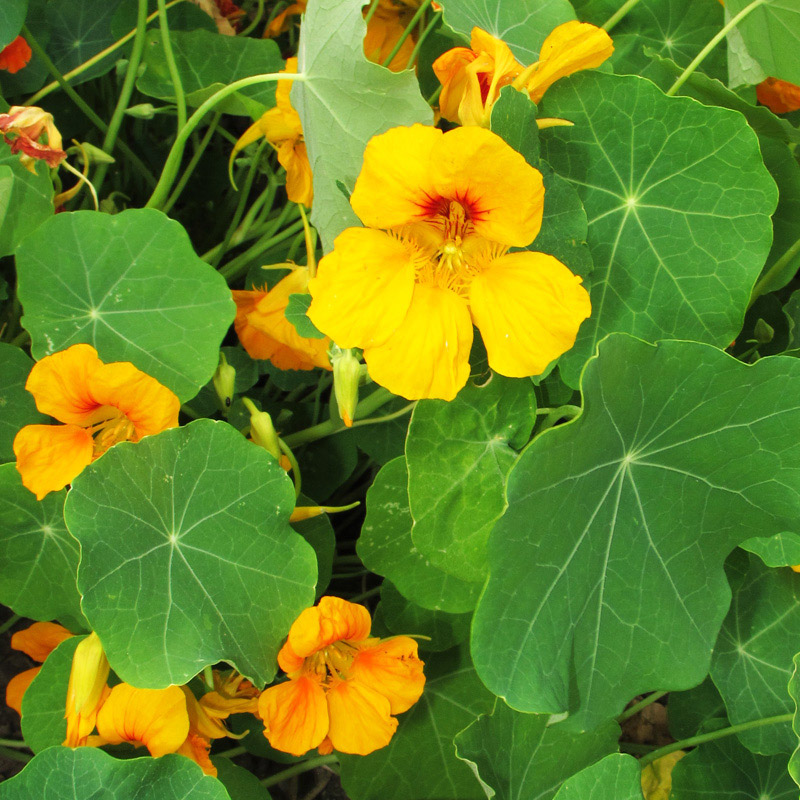Botanical name
Tropaeolum majus L.
Family
Tropaeolaceae
Common name
Indian Cress, Garden Nasturtium, Monk’s Cress
Information about the plant
Nasturtium is native to South America and was introduced to Europe from Peru in 1684 by the naturalist Van Beverning. Today, it is cultivated as a popular ornamental plant in various garden forms.
The genus name Tropaeolum is derived from the Greek word ‘tropaion’ or the Latin ‘tropaeum’. These terms referred to the enemy's weapons (armor, shield, and helmet) hung on a pruned tree as a sign of victory (trophies!). Linné was reminded of this image when he saw the nasturtium growing on a climbing frame and then derived the name Tropaeolum from tropaeum.
The leaves of nasturtium are shield-shaped, and the orange flowers with long nectar spurs resemble, especially when viewed from the side, the helmets worn in earlier times. The German name ‘Kapuzinerkresse’ also refers to the shape of the flower, which resembles the hoods worn by Capuchin monks. Since the plant, especially the fruit, has a slightly pungent taste like garden cress (Lepidium sativum), the name ‘Kapuzinerkresse’ (Capuchin cress) was coined. The flowers and leaves are suitable as ingredients in salads, herb and quark mixtures, or finely chopped on buttered bread.
Nasturtium is a creeping or climbing perennial herbaceous plant that uses its leaf and flower stalks to climb. The leaves, 3 to 5 cm in diameter, are peltate and have long stalks. The large red, yellow, or orange flowers consist of five petals. The sepals form a calyx with an upper lip of three and a lower lip of two fused sepals. The calyx forms a 3 cm long, pointed nectar spur, which secretes a sweet and pungent juice. The flower buds resemble capers in shape and were traditionally pickled in vinegar and eaten as ‘German capers’. The flowering period is from June to July.
Medicinally used parts of plants (herbal drug)
The fresh or dried herb consisting of leaves, leaf stalks, and flowers (nasturtium herb - Tropaeoli herba) is used.
Constituents of the herbal drug
Nasturtium herb contains mustard oil glycosides (= glucosinolates). When the plant is cut or dried, these come into contact with the enzyme myrosinase, which is stored in specialized cells. The mustard oil glycosides are hydrolyzed (splitting off the sugar residue), resulting in the formation of volatile, mucous membrane-irritating, pungent-tasting mustard oils (as in mustard, horseradish, etc.). Glucotropaeolin is the main glucosinolate in nasturtium herb, which hydrolyzes to benzyl isothiocyanate (benzyl mustard oil).
Quality of the drug
There is no pharmacopoeia quality description available for nasturtium herb (Tropaeoli herba).
Medical applications
Recognised medical use
Nasturtium herb has not been evaluated by the HMPC or ESCOP.
In combination with horseradish root, clinical studies have shown the following application (approved indication): for the relief of symptoms in acute inflammatory diseases of the bronchi, sinuses, and urinary tract.
Traditional use
Nasturtium herb has not been classified as a traditional medicinal product (Article 16a of Directive 2001/83/EC).
Herbal drug preparations in finished dosage forms
- Chopped nasturtium herb for tea preparation
- Powdered drug in tablets
- Fresh plant juice as juice
- Tincture in drops
- Tropaeolum homeopathic mother tincture in ointments
Dosage
Finished medicinal product: See patient information leaflet.
Tea: Drink one cup of nasturtium herb tea two to three times daily.
Fresh plant juice: 30 g per day.
Preparation of a tea
Pour 1 liter of boiling water over 30 g of fresh nasturtium herb or 3 g of dried nasturtium herb, and strain after 10 to 15 minutes. Boiling for longer periods reduces the effectiveness of the herb.
Notes
There are no studies available on the safety of nasturtium herb during pregnancy or lactation. The use in children under 12 years of age is not recommended due to a lack of evidence.
Side effects
When taken internally, nasturtium herb can cause irritation of the gastrointestinal mucous membranes due to its mustard oils. When used externally, it may cause skin irritation, especially when using fresh plant material.
Interactions
None known.


